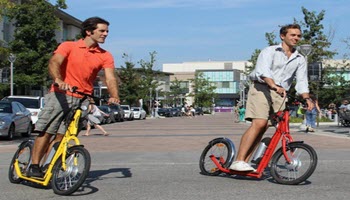 If you live in a major US city, you’ve more than likely encountered an electric scooter on the streets. Even if you’ve visited one of those cities, you may have seen a scooter sharing service such as Lime, Bird, Jump, Spin, Bolt or any other. The list is constantly growing with new companies launching almost monthly. Here in Los Angeles, I can step out of my apartment and find dozens of scooters available for my use. When it comes to short trips to the cafe, store, post office or whatever errand you have, these little guys make it easy and cheap to get around. You never have to get in your car, there’s no gas to pay for (they’re all electric and charged) and you never have to worry about paying for parking. The idea is genius and it begs the question– are we going through a tech-transportation revolution?
If you live in a major US city, you’ve more than likely encountered an electric scooter on the streets. Even if you’ve visited one of those cities, you may have seen a scooter sharing service such as Lime, Bird, Jump, Spin, Bolt or any other. The list is constantly growing with new companies launching almost monthly. Here in Los Angeles, I can step out of my apartment and find dozens of scooters available for my use. When it comes to short trips to the cafe, store, post office or whatever errand you have, these little guys make it easy and cheap to get around. You never have to get in your car, there’s no gas to pay for (they’re all electric and charged) and you never have to worry about paying for parking. The idea is genius and it begs the question– are we going through a tech-transportation revolution?
Tech And Transportation
Tech and transportation have always been closely intertwined– from the invention of the wheel, steamships, and the Model T all the way to Uber, scooters and the promise of self-driving cars. Many times, technology focuses on improving our lives in meaningful ways and getting around has always been a major focus. The wheel, steamships and the Model T revolutionized how we get from point A to point B, even changing how we build our cities. Could scooters in our urban cores do the same?
Electric Scooter Pros
First, let’s look at the benefits. Scooters are relatively cheap. Most have a dollar unlocking fee and then charge anywhere from 10- 25 cents a minute depending on location. That’s as low as $2.10 for a ten-minute ride. Since scooters can go up to 15 miles per hour, those ten minutes can get you pretty far. They’re also easy and convenient. Don’t want to wait in traffic in a car? A scooter can zip by on the bike lanes. Going somewhere with limited parking? Scooters can be parked anywhere on the sidewalks. Maybe you’re going somewhere that isn’t too far but not close enough to walk– your friend the scooter is here. And if you don’t have a car or take the bus, getting to your destination quickly is now possible. Now imagine half of all people in the city use a scooter instead of a car. Goodbye traffic congestion.
Electric Scooter Cons
Yet, the reality is that scooters aren’t as perfect as we’d like. They’re limited in range– about 20 miles per charge. They’re not as safe as taking a car since you’re riding exposed, and most people don’t wear helmets. Even with fairly affordable pricing, after about 15 minutes of riding you’d be better off paying for a quick Uber or driving yourself. What about drunk driving? The accidents we’re hearing about? Not to mention the horrendous sight we’ve all seen of scooters pushed over on the sidewalk in an ugly pile (people, stop pushing them over). These are all questions these tech companies have yet to solve. The technology is fairly young and it shows– there are still a few hurdles to jump.
Electric Scooter Solutions
That’s the conversation happening across the country. Here in LA, the city council often discusses banning scooters in certain parts of the city. Across the nation and the world, cities are in discussion about whether to ban or allow this new mode of transportation. Sure, it’s convenient but the infrastructure isn’t as quick to adapt to this change and safety remains a top concern. Even the population seems to be divided between full enjoyment and acceptance of this newcomer and those who detest the sight of these two-wheeled contraptions.
 Despite the dichotomous conversations, I think we have to adjust and adapt. When I take a scooter in Los Angeles, particularly in any densely populated neighborhoods like Downtown or Hollywood, I can’t help but wonder– is this the new way to get around? I envision bike lanes full of commuters on scooters, parking lots chock full of scooters and maybe even the dream of less traffic on our streets. Sure, it’s not foolproof and even with more advancements, I’m not sure scooters will get that much safer or faster. But even if we have fewer cars on the streets in the densest of areas, that’s a win for me. We’re not reinventing the wheel here, but maybe we can change a few of the broken spokes while we wait for autonomous cars and flying shuttles.
Despite the dichotomous conversations, I think we have to adjust and adapt. When I take a scooter in Los Angeles, particularly in any densely populated neighborhoods like Downtown or Hollywood, I can’t help but wonder– is this the new way to get around? I envision bike lanes full of commuters on scooters, parking lots chock full of scooters and maybe even the dream of less traffic on our streets. Sure, it’s not foolproof and even with more advancements, I’m not sure scooters will get that much safer or faster. But even if we have fewer cars on the streets in the densest of areas, that’s a win for me. We’re not reinventing the wheel here, but maybe we can change a few of the broken spokes while we wait for autonomous cars and flying shuttles.
—


We have a test pilot program here in Montreal. All electric vehicles (bikes and scooters) must be used with a helmet, though the police are not forcing the issue yet (season is almost over).
Many users do not replace the vehicles in their proper parking places, abandoning them wherever. This is gonna cause users fines on their credit cards since unless returned, they are still billed. Then comes the charging issue. I notice and hear on the news that this influx of added vehicles which is only allowed in cycle lanes, are creating a traffic issue to regular bike drivers. Forget that regular people walk and job in those bike lanes as well. Then there are the skate boards. Must be forgetting something. (Only vehicles with a license plate are permitted on city streets in most areas)
Now, unlike LA and other cities which have little or no snow, here in Montreal, we are a Winter land city. And how many folks want to be out doors with little or no protection when it rains, be it on bikes or other unsheltered vehicles?
I see this as nothing but a fad, Mindblower!
Mindblower!
The reality of the electric scooter is such that the technology has entered the marketplace and in this case the streets faster than the infrastructure, cities and people can keep up. Like with all new technologies, there are often more problems caused than get fixed in the first few years. The problem with helmets and parking persists in all areas and is one of the big hurtles for every E-Scooter company. So are the problems in parking space, legal issues and safety. I’m not sure if Montreal has a lot of bikers, but here in LA and many US cities, the bike lanes have ample bandwidth to support electric scooters thus far. As you mentioned in snowy environments, these are not quite the perfect year round solution, that much is true.
These issues are where the public, local government and the companies themselves have an opportunity to make this better or royally mess this up. The time to solve all these issues is now and we can pick to ban these or regulate in a meaningful way. Either way, we can’t avoid scooters any longer! I imagine the first round of “Motor Coaches” were just as controversial and unchecked at first. Now, cars are an everyday reality.
Excited to see how this unfolds in the next few years!
I don’t live there, but Atlanta, GA has been having issues with the electric scooters. According to the Atlanta Journal-Constitution, there have been four fatalities this past summer and numerous injuries. Authorities have been wrestling with how to gain control of the situation. In Georgia, motorized vehicles are not allowed on sidewalks and the city doesn’t have the infrastructure to accommodate the increasing number of pedestrians, cyclists, skateboarders and scooters. In my experience, getting around Atlanta streets is best done with a few hundred pounds of steel around you. College towns in Georgia have had same issues.
The companies that rent the scooters just started to set up the stations and, from my understanding, didn’t consult with local authorities except to get a business license. The laws haven’t caught up yet and there aren’t many rules.
Mark,
Safety, in my opinion, is the top downfall and challenge e-scooters face. Fatalities are everywhere and injuries too. Not to mention drunk “scootering” is an issue in all areas. The hard part about this is that technology can help curb things like drunk riders (disabling a scooter if they detect a wobbly drunk rider) but enforcement is a real issue. Here in LA, just like in other markets, police are being trained on how to deal with these issues. I’ve seen tickets for riding on sidewalks and for running a red light (another common problem). The reality is that infrastructure and law enforcement is slow to catch up to the mass amount of riders on the streets.
There’s plenty of laws and regulations to come in the future of this very young industry, probably as the result of the inevitable lawsuits. It’s hard to see the positives when there are so many downsides to these two-wheeled guys. I know plenty of instances where they’ve been useful but I’d love to see some studies on the facts of traffic reduction and savings.
Lots to come from the scooter world in the future, much of which to be clouded by controversy I suspect.
$ 11 USD for a ten minute ride ? You have obviously got more money to burn than me !
Reg,
If you were my math teacher, you’d give be a big old “F” on this article. I meant to put the cost as $2.10, but I accidentally wrote $11. A ten minute ride for $2.10 is much better than $11!! I’m going to fix that, so thank you for calling attention to it.
In fact, I would also not burn $11 on a 10-minute ride! Unless that ride comes with a lunch and some AC 🙂
Thanks!